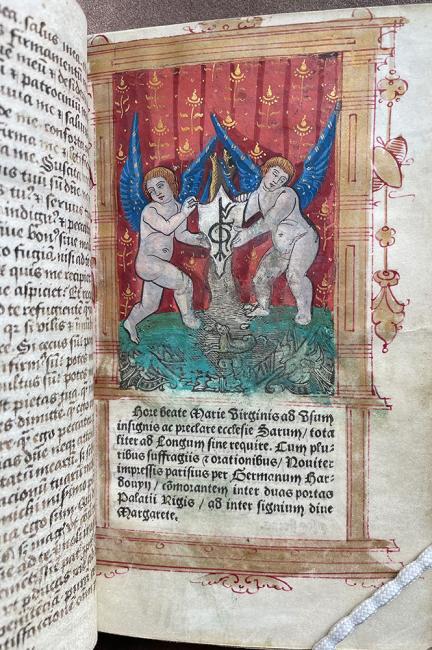This is a guest post by Kate McCaffrey, MA, University of Kent, Department of Medieval and Early Modern Studies.

Figure 1: Hore beate Marie Virginis (Paris: Germain Hardouyn, [about 1528]). Purchased by Pierpont Morgan, 1906; PML 1034, fol. A1r.
During my recent research for my master’s degree in medieval and early modern studies at the University of Kent, I was lucky enough to work with a hugely understudied printed Book of Hours once owned, and written in, by Henry VIII’s ill-fated second wife, Anne Boleyn. This humble volume, currently held in the private collection at Hever Castle in Kent, has proved to be a mine of new and exciting information. Alongside uncovering erased inscriptions, which have allowed me to reconstruct the sixteenth-century provenance of this Hours and link its history to Anne’s daughter, Elizabeth I, I came across an intriguing connection with a volume at the Morgan Library & Museum.
Hever’s Hours was produced in Paris and printed on parchment by the prolific French printer Germain Hardouin, likely in the year 1527 due to the inclusion of an almanac for the year 1528. One aim of my research was to try to trace the other copies of this edition with the hope of further illuminating its early provenance. To my excitement, I found what appeared to be another copy of the very same edition held at the Morgan (PML 1034). The description matched the physical properties of Hever’s Hours, but it was the provenance of the Morgan’s Hours that particularly sparked my interest, for this Hours was once owned by another leading sixteenth-century female. In fact, the original owner of the Morgan’s Hours was none other than Henry VIII’s first wife and the queen of England at the time of the book’s production, Catherine of Aragon.
The ownership by both of Henry’s first two wives of a copy of the same edition holds hugely intriguing implications for their relationship with one another and their book ownership. Both Catherine and Anne are well known for being highly educated women who owned and used many books and certainly had access to multiple copies of Books of Hours. Yet their connection to one specific edition is different. It is a connection that comes from a pivotal moment in the English court when Catherine’s star was waning and Anne’s rising. Anne owning a copy of the same edition as Catherine is surely, if nothing else, an emulation of, and aspiration to, the royal status of queen which Anne herself would hold in only seven years’ time.

Figure 2: Hore beate Marie Virginis (Paris: Germain Hardouyn, [about 1528]). Purchased by Pierpont Morgan, 1906; PML 1034, fol. E5r.
Despite the travel restrictions imposed by the COVID-19 pandemic and thanks to the generosity of John McQuillen, the Morgan’s associate curator of printed books and bindings, I was able to view several pictures of specific folios within the Morgan’s Hours to assist in my research. This proved invaluable. A comparative analysis of Hever’s and the Morgan’s Hours showed clear differences in the decoration of the book, signifying a level of customization within the illuminating workshop overseen by Hardouin himself. This is particularly suggestive when considering that Anne’s copy features a greater level of decoration than Catherine’s. Perhaps this was simply a reflection of Anne’s taste or perhaps it embodied more for her and is an insight into her personal ambition.
Another key issue that arises from Catherine and Anne both owning a copy of the same edition is, quite simply, why? An attractive possibility would be that Henry presented his first two wives with the same book, and indeed it seems feasible that these books were gifted to Catherine and select members of her household, of which Anne was one. Another possibility is that Catherine ordered these books for herself and her household, or perhaps Anne and Catherine heard of the production of these books and each requested a copy. More research needs to be done into issues like this, and I will be continuing with my study in this vein. What is certain is that this new information links two of sixteenth-century England’s most recognizable women, who were great rivals in love and power, to one simple, printed prayerbook. Indeed, perhaps the most compelling image of all is, in the midst of extreme strife in their personal lives, these two remarkable women possibly using this same humble book together, united in a moment of peaceful prayer.
For further reading on Anne Boleyn’s Book of Hours at Hever Castle, see McCaffrey’s “Hope from Day to Day” in the Times Literary Supplement, no. 6164, 21 May 2021.
Kate McCaffrey, MA
University of Kent, Department of Medieval and Early Modern Studies
@kateemccaffrey
Website
Kate E. McCaffrey has recently completed her master's degree with distinction in medieval and early modern studies at the University of Kent. She completed her undergraduate degree in history at the University of Warwick. Kate worked at Hever Castle for six years in between studies and will now be re-joining them as a historian and researcher to continue her work with their two Books of Hours.
